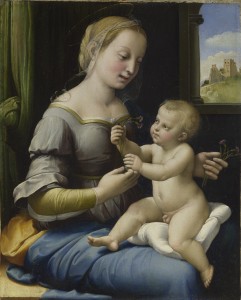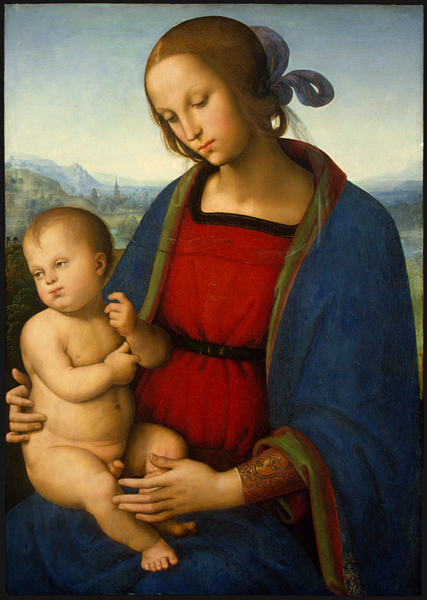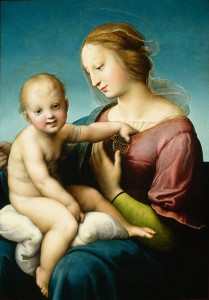Perugino’s Influence
Raphael’s Small Cowper Madonna mirrors the style and mood of those from Perugino’s shop. But compare these two Madonnas. While the Virgins share a graceful modesty and wistful expressions, the two paintings differ compositionally. Raphael’s figures are tied by interlocking gestures and unified by their shared gaze to a vision of the child’s future. By contrast, Perugino’s recycling of stock figures from workshop repertoire sometimes resulted in figures that are unrelated or gestures that are unexplained by the story being told. Was the child here meant to hold something, as he perhaps did in another painting? Unlike Raphael’s mother and child, who form a seamless unit, Perugino’s seem to exist in separate worlds.
After studying with his father in Urbino and working in the busy shop of Perugino, Raphael moved to Florence. During his few years there, between 1504 and 1508, he is known to have painted at least seventeen small devotional panels of the Virgin and Child. He likely made most for an avid market, but it appears that Raphael had more than a commercial interest in the image. He gave three—one as a wedding present—to friends. (Paintings of the Virgin and Child were popular wedding gifts.) He also made drawings of the Mother and Child that he never translated in paint; they seem, instead, to be personal explorations. From Raphael’s entire brief career some thirty-four paintings of the Virgin and Child survive. The artist’s mastery developed as he absorbed the lessons of not only his first teachers but also Leonardo and Michelangelo and the ancient art he saw in Rome. The grace of Raphael’s Madonna paintings—their idealized beauty and tender sentiment—came into harmony with their subtly constructed meaning.
The Madonna of the Pinks

Raphael
The Madonna of the Pinks (La Madonna dei Garofani), c. 1506–7
Oil on panel, 22.9 x 27.4 cm (9 x 10 13/16 in.)
The National Gallery, London
© National Gallery, London/Art Resource, NY
This tiny panel (measuring only 9 inches across) shows the Virgin and Child in a bedroom—the curtain of a bed appears behind her. In all likelihood the owner, possibly sitting in her own bedroom, would have held the panel in her hand as she contemplated it and made her devotions. Linking the two figures are the flowers they pass between them—pinks, which because they were symbols of marriage, point to the Virgin as not only the mother but also the bride of Christ.
With the beginning of the sixteenth century, the popularity of the type of Virgin and Child paintings explored here began to wane. They no longer dominate the inventories; new religious themes proliferated. While the old formulas continued to attract patrons and artists, for many, especially those, like Raphael, who moved in sophisticated humanist circles, traditional piety and the conventional images that served it became less satisfying personally, intellectually, and emotionally. The source of authority in religious art—what made an image awe-inspiring—was shifting away from the subject depicted and the viewer’s devotion to it. Instead, new value was given to the invention and talent of the artist, especially his (rarely her) ability to elicit and elucidate religious (or any other) sentiment. For some patrons, what counted most was simply aesthetics. In 1524, Federico Gonzaga asked Baldassare Castiglione to acquire a work by Raphael’s one-time assistant Sebastiano del Piombo. The subject was immaterial “so long as it is not about saints, but rather something lovely and beautiful to look at.”21



